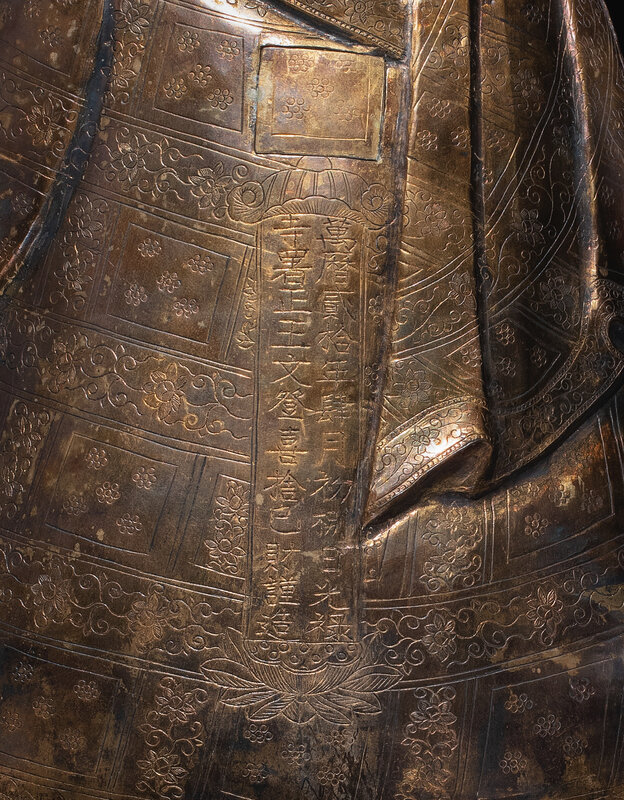Sotheby's. Bodies of Infinite Light Featuring an Important Collection of Buddhist Figures Formerly in the Collection of the Chang Foundation, New York, 10 Sep 2019
A rare inscribed gilt-silver figure of Amitabha, dated Wanli 20th year, corresponding to 1592
Lot 311. A rare inscribed gilt-silver figure of Amitabha, dated Wanli 20th year, corresponding to 1592. Height 14 1/3 in., 36.5 cm. Estimate USD 60,000 — 80,000. Lot sold 137,500 USD. Courtesy Sotheby's.
the Buddha cast in vajraparyankasana and dhyana mudra with the palms incised with six-spoke dharmacakra, the hair in neat whorls over the ushnisha and the face in a serene state of meditation, wearing a kasaya of patchwork squares draped over the rounded shoulders and a similarly decorated dhoti, both with incised flowers and lotus meander, the back of the robe with an incised dedicatory inscription within a rectangular cartouche, all raised on a two-tiered lotus petal base further raised on a pierced hexagonal standard and terminating with a foot of lotus lappets, sealed with a metal plate.
Provenance: The Chang Foundation Collection.
Literature: Jintongfo zaoxiang tulu/Buddhist Images in Gilt Metal, Taipei, 1993, pl. 6.
Note: The inscription on the reverse of this figure translates to: 'Wanli twentieth year, fourth month, eight day, at Guanglu Temple, Wang Wendeng commissioned this statue'. Guanglu Temple was actually not a temple for worship, but was the name of the Imperial department charged with procuring and organizing the provisions for banquets for important state occasions and the Imperial household. The department's origins date back to the Northern Qi dynasty, however its name and function evolved over time. In the Yongle period, the name was changed to Guanglu Temple, administered under the Ministry of Rites. The department lasted until the 32nd year of the Guangxu reign, corresponding to 1906. During the Wanli period, Wang Wendeng was in charge of Guanglu Temple, and likely commissioned this figure of Amitabha to bring luck to the department in its daunting endeavors.
Existing silver figures from the Wanli period are few in number, as are Wanli figures with dated inscriptions; the combination of the two elements would suggest that the present figure is exceedingly rare. The ring-punch design employed in one of the floral motifs of the robe is a technique of silver decoration used since the Tang dynasty, when Central Asian visitors along the Silk Route introduced their metalworking traditions to China. For an example with the ring-punch technique on a gilt-silver repoussé vessel, see a Tang dynasty footed bowl in the Metropolitan Museum of Art, New York, acc. no. 1974.267. For an earlier example of the chasing technique employed on the lotus petals on the base of the present figure, see a Southern Song dynasty silver lotus-form cup, illustrated in the Zhongguo wenwu jinghua daquan/ Compendium of Chinese Art: Gold, Silver, Jade, Stone, Hong Kong, 1994, pl. 145.

/https%3A%2F%2Fprofilepics.canalblog.com%2Fprofilepics%2F1%2F0%2F100183.jpg)
/https%3A%2F%2Fstorage.canalblog.com%2F03%2F02%2F119589%2F96711876_o.jpg)
/https%3A%2F%2Fstorage.canalblog.com%2F11%2F31%2F119589%2F94773502_o.jpg)
/https%3A%2F%2Fstorage.canalblog.com%2F20%2F83%2F119589%2F94772815_o.jpg)
/https%3A%2F%2Fstorage.canalblog.com%2F26%2F72%2F119589%2F75604929_o.jpg)
/https%3A%2F%2Fstorage.canalblog.com%2F59%2F60%2F119589%2F26458628_o.jpg)




/http%3A%2F%2Fstorage.canalblog.com%2F37%2F05%2F119589%2F120373916_o.jpg)
/http%3A%2F%2Fstorage.canalblog.com%2F60%2F10%2F119589%2F113139827_o.jpg)
/http%3A%2F%2Fstorage.canalblog.com%2F48%2F83%2F119589%2F96649014_o.jpg)
/http%3A%2F%2Fstorage.canalblog.com%2F74%2F46%2F119589%2F95895471.jpg)